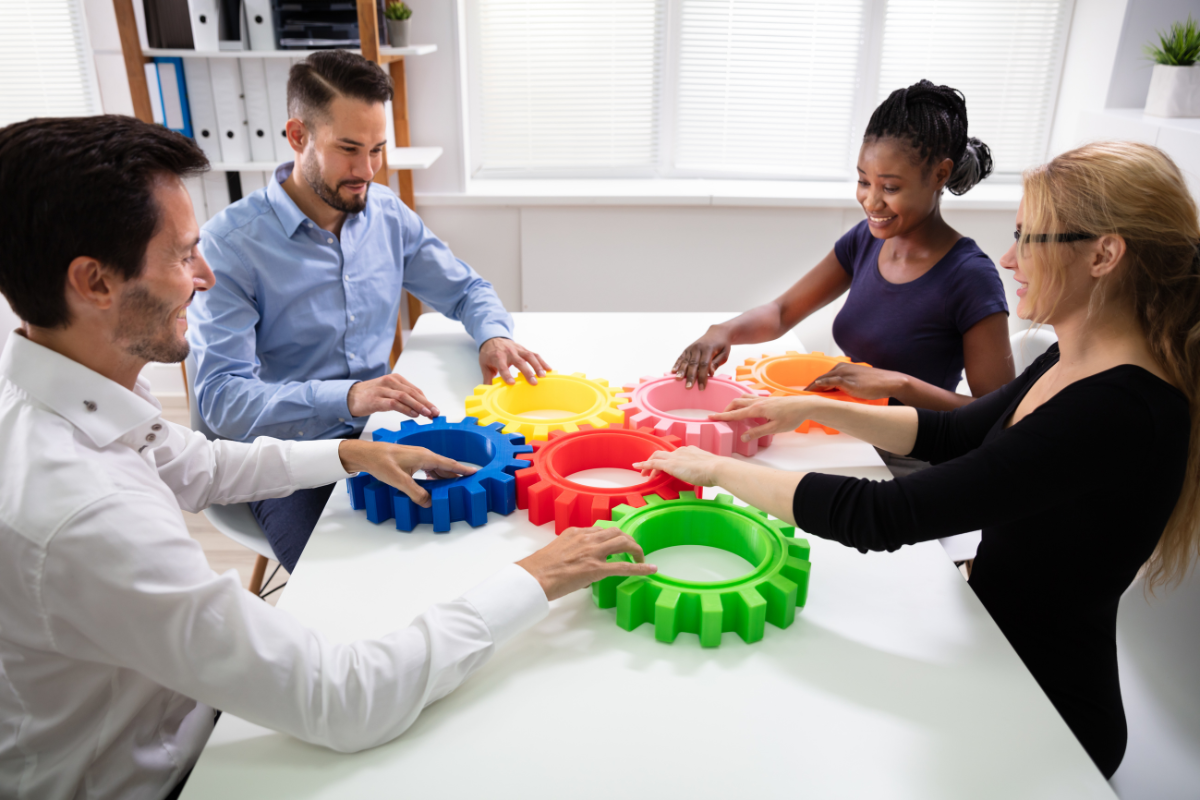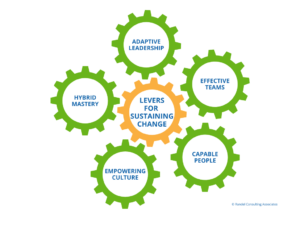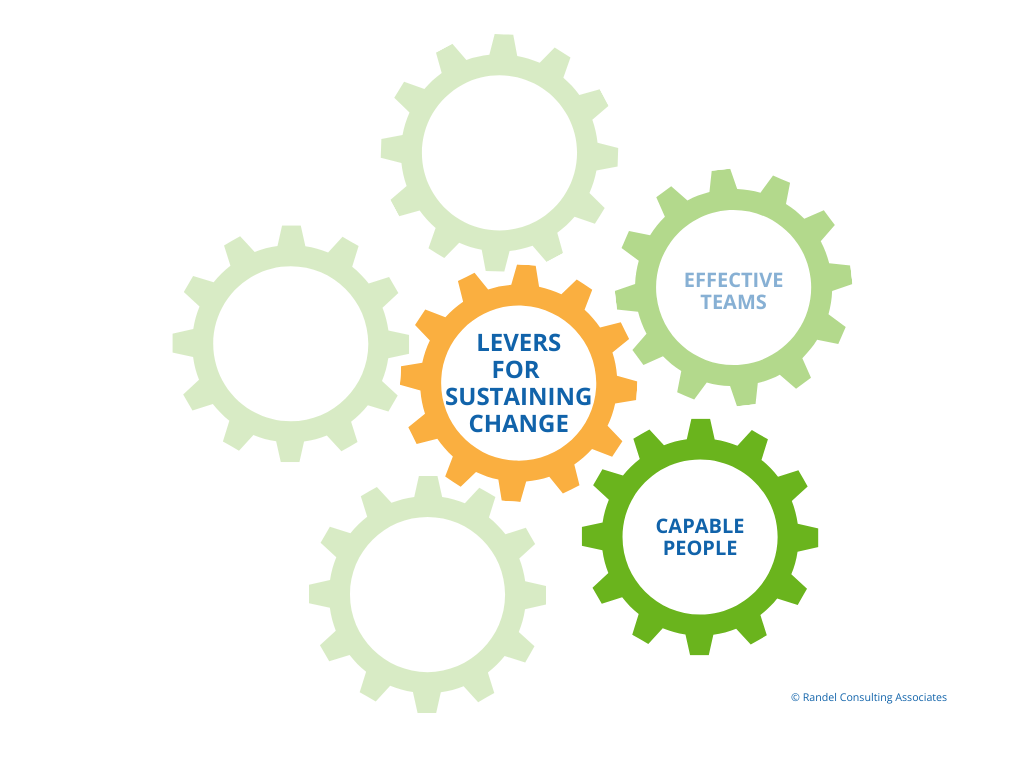How do you create and sustain change? What enables all the constituent elements of change to stay connected with one another, interacting in ways that maintain and sustain forward momentum?
In our previous newsletter, we introduced the RCA Levers for Sustaining Change as a way of looking at five interlocking elements that will keep you moving forward and maintaining the processes and impact of change.
We identified Effective Teams as the essential first lever. Now it’s time to meet the second lever!
#2. Capable People
The primary lever in sustaining change is an effective team. Small groups are the engine of change, and they have a primary role in creating and sustaining change.
However, teams are only as strong as the people within them. It’s the approach, knowledge, skills, experience, and expertise of the individual members of the team that collectively creates the magic of a high-performing team.
I’ve worked with hundreds of clients over the course of my career, in a wide variety of settings. I am impressed with the dedication and commitment that people bring to their work, and that includes their interest in improving the health and effectiveness of their organizations.
And yet there can often be something missing, holding people back from being as capable and impactful as they might be. It varies from person to person, so let’s have a look at some of the elements of a Capable Person:
Skills and Experience: The Foundation of Capability
Capability starts with skills and experience. Do you have the know-how? Can you get the job done?
While the technical skills (the core aspects of the job, whether engineering, advocacy, or fund-raising) are certainly important, they are not the only skills needed for contributing to effective teams and to sustaining change.
There are other essential skills that make people valued in an organization. Think about teamwork, people management, and the ability to collaborate seamlessly. All these components make someone a colleague that can be relied upon.
Attitude and Values: What Drives You?
The second element is attitude and values. What motivates you? Are you driven by a sense of mission, progress, and delivering results? Attitude and values are key to fostering a collaborative, mission-oriented environment. We appreciate people who have an orientation to working with others to achieve common goals, while we get suspicious about those who appear to solely be driven by personal gains. This is about being part of something bigger than ourselves.
Willingness and Motivation: A Third Piece of the Puzzle
While necessary, skills and attitude alone won’t really enable a person to be capable. Someone can possess all the skills and experience to be part of a change team, but lack the motivation to put these in service to the team. Willingness is crucial. It’s about being enthusiastic and eager to contribute. Without this final piece, capability remains incomplete.
So, capability is the harmonious alignment of skills, attitude, and motivation, working in concert, driving the contributions of people to their teams, and sustaining the organization’s impact.
But how are we, as leaders, to nurture Capable People across our teams?
Nurturing Capability Through Learning
A central task of leaders is developing their people—to do their current work well and to prepare them for their next role. As people gain experience and rise in an organization, they are typically turning their attention to a bigger stage—from contributing within their teams to working across the organization.
It is common that the people reporting to you as a leader have already gained technical knowledge and experience. They know how to do their current jobs, leaving you to nurture their attitude/orientation and their motivation, supporting them in developing newer skills and ways of working that will serve them into the future.
There are two main ways to shape people that require only time and interest:
Encourage a Learning Orientation: Embrace a learning mindset. Be eager to learn, improve, and become more effective. Encourage a culture of continuous learning within your team and organization.
“Learn-In-Place” Opportunities: Utilize opportunities across the workplace to learn and grow. Stretch assignments, job shadowing, and collaborative projects with experienced colleagues are powerful learning experiences.
One of our clients was embarking on an organization-wide change initiative. Having developed a new strategy to meet changing times, this change required a refreshed organization structure and ways of working that would impact everyone in the organization. They were also adding new staff as part of their growth plan.
Working with this client, we established a “Transition Monitoring Team” to support the change initiative and to nurture the capability of staff in leading and influencing change. Regular monthly meetings of the team are an opportunity for them to interact with senior leaders on the tone of the organization, exploring how the changes are impacting staff. They also serve as a ‘sounding board’ to leadership, responding to early ideas and concepts, and suggesting ways for these to be a better fit for the organization.
Part of our role, as the external consultants, is to grow the capability of team members to work with change. Over the first two years of this work, we have introduced a process of creating Team Charters, and we have helped them learn to conduct a Pre-Mortem and an After Action Review. We have helped them understand that organizations go through phases of development as they mature, and they have grappled with how to shape their workplace culture.
This team is not only serving as a valued partner to senior leadership, it is also developing staff who now appreciate the challenges of leading change in an organization. And they are more capable of supporting the organization’s goals.
As we continue to build capable people and teams, remember that capability is a dynamic process. It’s about aligning skills, attitudes, and motivation while nurturing a culture of learning and development.
How do you find ways to nurture and support Capable People in your organization?
Drop me a line and let me know!
Until next time,
Learn more about the other levers: Effective Teams, Empowering Culture, Hybrid Mastery and Adaptive Leadership




